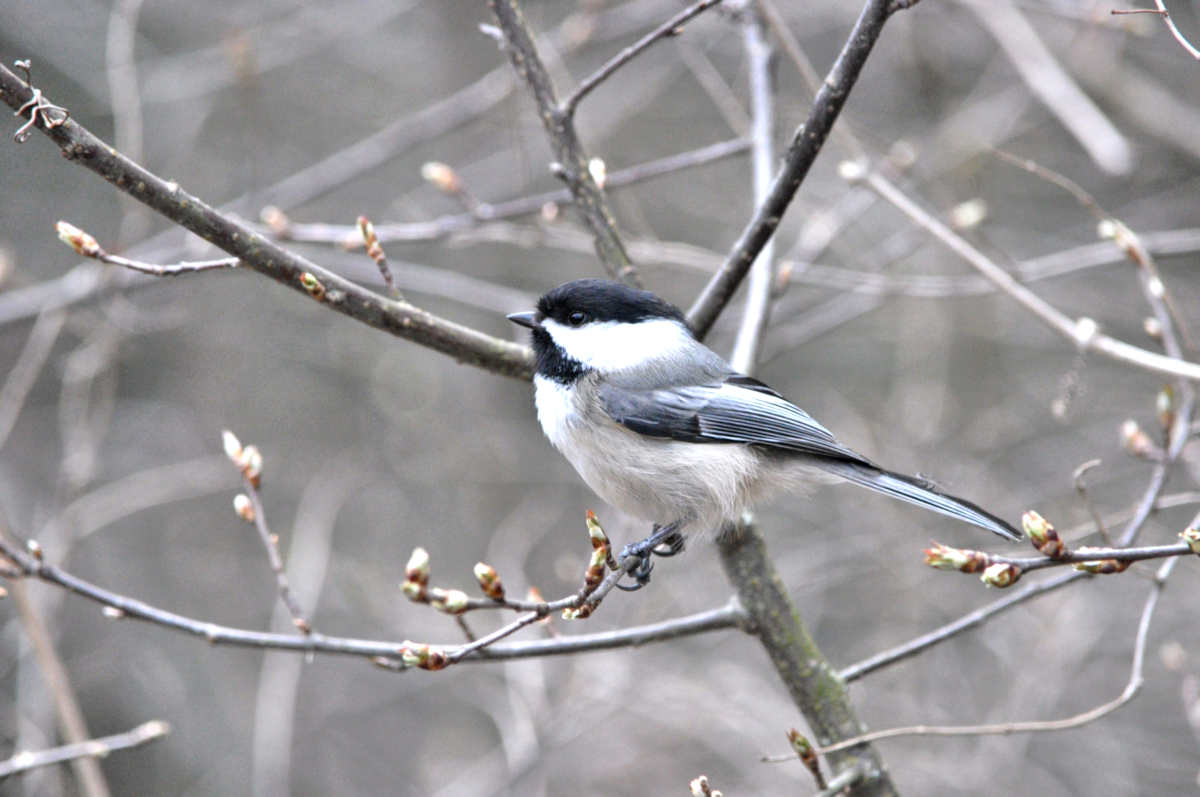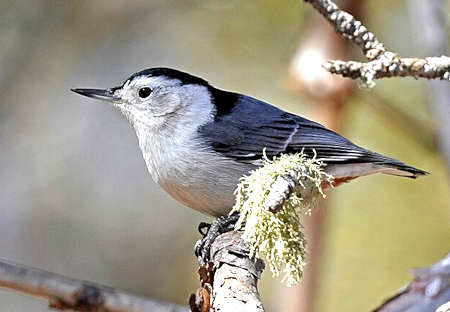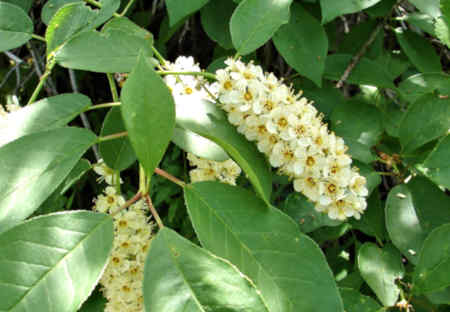Chickadee Guide
The Mighty Chickadee: A Tiny Bird with Big Personality
Fast Facts
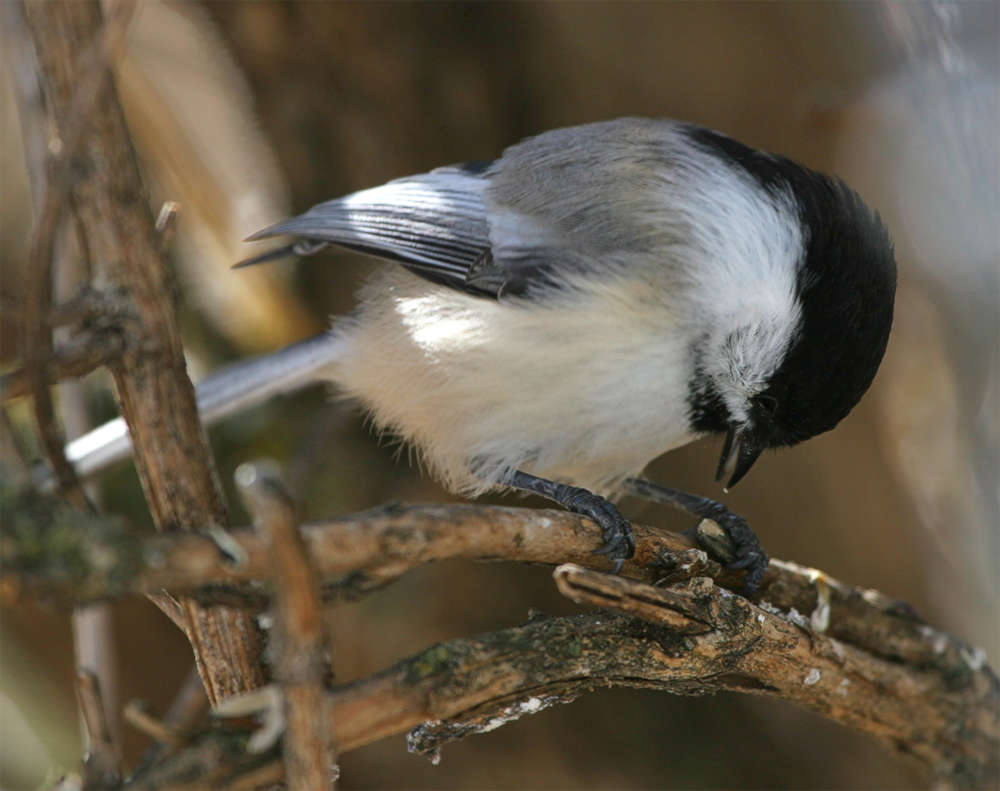
The chickadee will select a single seed from the feeder, then retreat to a nearby branch where it skillfully taps it with its beak to crack it open.
Scientific Name: Poecile sp.
Habitat: Found in forests, woodlands, suburban areas with tree cover across North America.
Size:Small: 4.7-5.9 inches (12-15 cm) in length.
Diet: Omnivorous—eats seeds, nuts, berries, and small insects.
Lifespan: Typically 2-3 years in the wild, but can live for much longer.
Range: Various species are found throught the US.
Migration: Non-Migratory
Flocks: Chickadees often travel in mixed flocks with other small songbirds, such as titmice, nutchatches, and finches.
Nesting: Cavity nesters; 6-8 eggs per clutch.
Parental Care: Feeds nestlings exclusively on soft insects, requiring thousands of caterpillars to raise one brood.
Bird House Entrance Size: 1 1/8" entrance hole.
Caching Behavior: Hides thousands of food items for winter, remembers them using an expanded hippocampus
Conservation status:Least Concern by IAUC.
How to Support Chickadees:Plant native plants, especially native trees.
Fun Fact: A chickadee will select a single seed from a bird feeder, retreat to a nearby branch where it skillfully taps it with its beak to crack it open.
The Secret Life of chickadees: Natures Tiny Acrobats
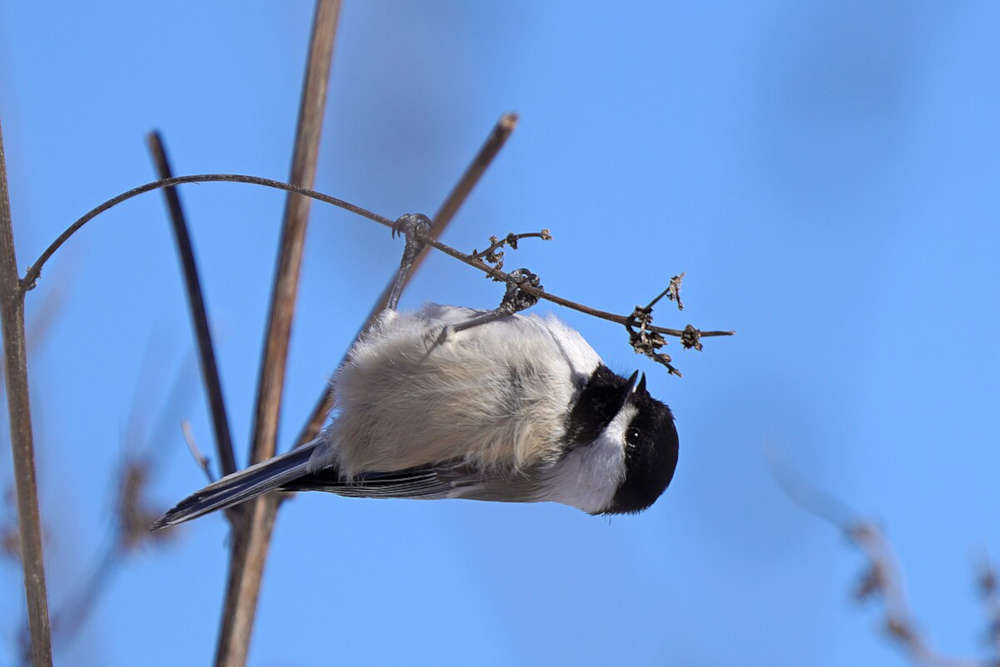
Chickadees are very acrobatic
Introduction
These tiny 5 inch songbirds are energetic and known for their curious nature and distinctive "chick-a-dee-dee-dee" call. Found across North America, these charming birds belong to the tit family and are easily recognized by their black-capped heads and white cheeks. Often seen flitting between trees, they are highly adaptable and thrive in a variety of habitats, from forests to suburban backyards. Known for their intelligence and friendly demeanor, chickadees are a beloved sight at bird feeders and a symbol of the winter landscape.
Chickadees are non-migratory songbirds. They are highly social and often form mixed-species flocks during the winter months, traveling and foraging with other songbirds like finches, nuthatches, and titmice. Flocking behavior helps them stay safe from predators and increases their chances of finding food. Their cooperative foraging also allows them to share information about the availability of food sources, strengthening their social bonds.
Species and Range
Black-Capped Chickadee (Poecile atricapillus)
The Black-Capped Chickadee is one of the most well-known and beloved songbirds of North America. Recognizable by its distinctive black cap and bib, white cheeks, and cheerful "chick-a-dee-dee-dee" call, this small bird is full of personality. Despite its tiny size, the Black-Capped Chickadee is remarkably hardy, thriving in some of the coldest regions of the continent. It is found throughout the northern half of the United States, and also down the Appalachian mountains.
Carolina Chickadee (Poecile carolinensis)
Another common species in the Eastern US is the Carolina Chickadee. This species closely resembles the Black-Capped Chickadee but is found primarily in the southeastern states. Carolina Chickadees are slightly smaller and have a faster, higher-pitched song compared to their northern relatives. They are found throughout the southeastern US, from parts of Texas to the southern half of Ohio and across to Maryland and Delaware. The two species have a narrow overlap zone where they sometimes hybridize, making identification tricky in those areas.
Other Species
The Black-Capped and Carolina Chickadees are just two of seven species of chickadees found in the United States. Each species has its own range and habitat preferences:
Mountain Chickadee (Poecile gambeli) - Native to the Rocky Mountains and western U.S., this species is easily recognized by its distinctive white eyebrow stripe. Prefers high-altitude coniferous forests.
Chestnut-Backed Chickadee (Poecile rufescens) - Inhabits coastal forests of the Pacific Northwest and parts of California. Known for its rich reddish-brown back and preference for damp, dense woodlands.
Boreal Chickadee (Poecile hudsonicus) - Found in Canada and the northernmost U.S., including parts of New England and the Great Lakes region. Stays in boreal spruce forests.
Gray-Headed Chickadee (Poecile cinctus) - A rare species found in Alaska's remote tundra forests, making it the least commonly seen chickadee in the U.S.
Mexican Chickadee (Poecile sclateri) - The only chickadee species found in the Southwestern U.S., particularly in the mountains of Arizona and New Mexico.
Diet and Seed Caching
Chickadees have a highly varied diet. During warmer months, they primarily consume insects, spiders, and caterpillars,
while in winter, they switch to seeds, berries, and suet. They are frequent visitors to backyard bird feeders, often taking sunflower seeds and peanuts.
One of their most fascinating behaviors is food caching. In autumn, chickadees collect tens of thousands of seeds and insects, hiding them
in tree bark, under leaves, or in cracks in wood. Remarkably, they are able to remember the locations of their food stores for weeks or even months.
To support this extraordinary memory, chickadees experience an incredible change:
their brains actually grow larger in the fall. The hippocampus, the part of the brain responsible
for spatial memory, expands to help them recall their food locations. In the winter and spring,
when memory demands decrease, their hippocampus shrinks back to its original size.
This unique ability allows them to survive harsh winters when food is scarce.
Nesting and Breeding Behavior
All Chickadees are cavity nesters, meaning they build their nests in natural tree cavities or abandoned woodpecker holes.
However, they are also capable of excavating their own nesting sites in soft or rotting wood.
For Carolina and Black-Capped Chickadees, breeding season begins in early spring, typically between April and June.
The female constructs the nest using moss, fur, feathers, and soft plant fibers, creating a well-insulated space for her eggs.
She lays 6 to 8 tiny white eggs with reddish-brown speckles, which she incubates for about 12-14 days.
Once the eggs hatch, the parents work tirelessly to feed their young.
Interestingly, Black-Capped Chickadees do not feed their nestlings seeds - instead,
they rely on a high-protein diet of insects, primarily caterpillars.
Research by Doug Tallamy has shown that a single pair of chickadees needs to gather betwene 6,000 to 9,000 caterpillars
to successfully raise one nest of chicks. This is why it's important to have Native Plants, as Non-Natives do not support Caterpillars. In Fact, Tallamy's reserach also showed that a property
with less than 70% native plants will actually REDUCE the chickadee population, since they will not be able to rear their young.
Chickadee Nestbox Specifications
Chickadees are cavity nesters and will often use a well-designed birdhouse as a substitute for natural tree cavities. The ideal box should be made of untreated wood, such as cedar or pine, with a 4 x 4-inch floor space and an 8 to 10-inch interior height. The entrance hole should be 1 1/8 inches in diameter, positioned 6 to 8 inches above the floor to keep nestlings safe from predators.
Mount the nestbox 6 to 15 feet above the ground on a tree or baffled pole in a shaded or semi-shaded area in woodlands or a group of trees. To protect against predators like raccoons and squirrels, install a predator guard - a metal or wood ring that extends the hole outward, making it harder for predators to reach inside. Do not add a perch. Perches are unnecessary and give predators easy access. A removable side allows for easy cleaning in the winter. Planting native vegetation nearby will support a caterpillar-rich habitat, essential for chickadee hatchlings.
Conservation and How to Attract Chickadees to Your Property
Black-Capped Chickadees are not considered endangered, but their populations can be affected by habitat loss, pesticide use, and climate change. Because they rely on tree cavities and an abundance of insects, their survival is closely tied to the health of forests and suburban green spaces.
You can help nuthatchs thrive by making your property more nuthatch-friendly:
1. Plant Native Trees and Shrubs
Native plants support the insect populations nuthatchs need to feed their young. Oaks, willows, birches, and dogwoods are especially beneficial because they host large numbers of caterpillars. Avoid planting non-native species, as they do not support the same biodiversity.
2. Provide Nesting Sites
Since Chickadees nest in cavities, leaving dead trees or snags in your yard can provide essential nesting sites. If that's not possible, consider putting up a chickadee-sized nest box with a hole about 1 1/8 inches in diameter to prevent larger birds from taking over the space.
3. Avoid Pesticides
Pesticides kill the insects that Chickadees rely on to feed their young. Keeping your yard pesticide-free will ensure that caterpillars and other insect prey remain available.
4. Offer Food and Water
Bird Feeders: offering these in winter can help them survive when natural food sources are scarce. I recommend black-striped and/or black oil sunflower seeds, as their tough shells prevent non-native sparrows and blackbirds from cracking them open, reducing competition with native songbirds.
Water Source: Birds love water sources. An addition of a water source, even a small bird bath will increase your bird numbers.
By planting native vegetation, preserving natural tree cover, and offering supplemental food in winter, you can help sustain healthy nuthatch populations while enjoying the sight and sound of these lively little birds year-round.
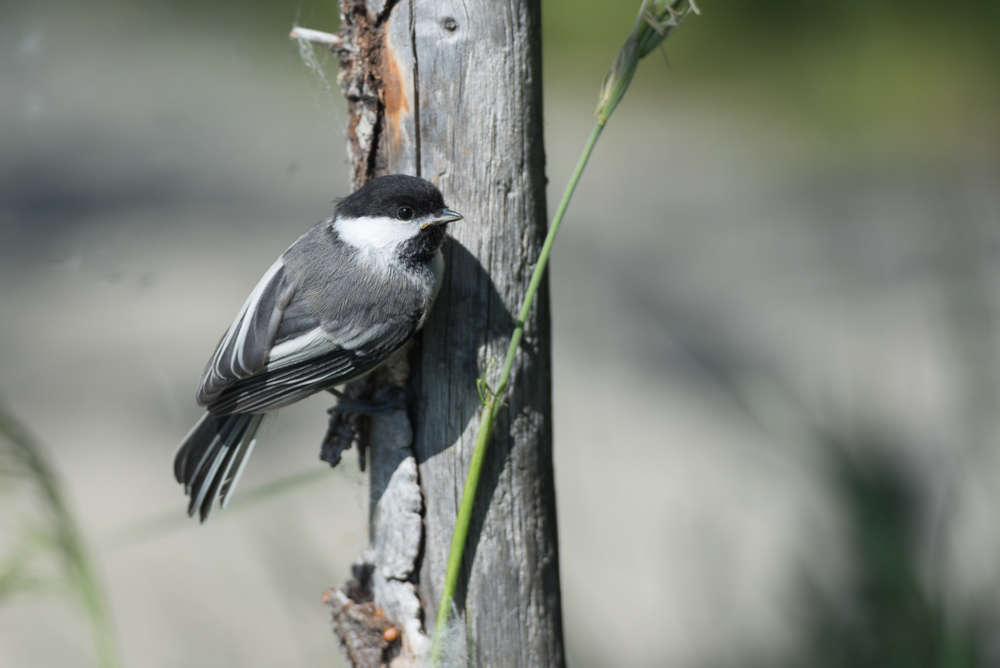
Chickadees are lively little birds that are fun to watch.
